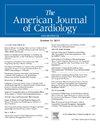Myocardial Revascularization in Patients With 3 Vessel Coronary Artery Disease and Chronic Kidney Disease: Coronary Artery Bypass Grafting Versus Percutaneous Coronary Intervention
IF 2.3
3区 医学
Q2 CARDIAC & CARDIOVASCULAR SYSTEMS
引用次数: 0
Abstract
Coronary artery disease (CAD) and chronic kidney disease (CKD) commonly co-exist. Superior outcomes with coronary artery bypass grafting(CABG) compared to percutaneous coronary intervention (PCI) have been identified in patients with 3 vessel CAD (TVD) and CKD but have been limited to mid-term follow-up. Herein, we analyzed the long-term outcomes of patients with TVD and CKD undergoing surgical versus percutaneous revascularization. 1,599 patients with CKD and TVD without STEMI or previous revascularization underwent coronary angiography between 2009 and 2018. The primary outcome was all-cause mortality. Secondary outcomes included rates of readmission for myocardial infarction (MI), stroke, repeat revascularization, and overall rehospitalization. 453 patients were included in the final analysis (PCI 373; CABG 80; median follow-up 9.3 years). All results are presented as CABG versus PCI. The rate of all-cause mortality at the longest follow-up (14.1 years) was significantly lower in patients who underwent CABG (68.9% vs 83.1%, p = 0.039, adjusted Hazard Ratio (aHR) 0.68, 95% confidence interval (CI) 0.47–0.98). Readmission rates for MI (10.2% vs. 28.4%, p = 0.009, aHR 0.37, 95% CI 0.17–0.77) and repeat revascularization (3.1% vs. 24.4%, p < 0.001, aHR 0.09, 95% CI 0.02–0.34) were also lower after CABG than after PCI. No significant difference was observed in the rates of readmission for stroke or all causes. In conclusion, in this retrospective single-center study, we confirmed that the previously described advantages of CABG over PCI in patients with CKD and TVD persist with extended long-term follow-up. CABG should be considered the gold standard approach to revascularization in this patient population.
三支冠状动脉疾病和慢性肾脏疾病患者的心肌血运重建术:冠状动脉旁路移植术与经皮冠状动脉介入治疗
冠状动脉疾病(CAD)和慢性肾脏疾病(CKD)通常并存。与经皮冠状动脉介入治疗(PCI)相比,冠状动脉旁路移植术(CABG)在三支血管CAD (TVD)和CKD患者中的效果更好,但仅限于中期随访。在此,我们分析了TVD和CKD患者接受手术与经皮血运重建术的长期结果。2009-2018年期间,1599例无STEMI或既往血运重建术的CKD和TVD患者接受了冠状动脉造影。主要结局为全因死亡率。次要结局包括心肌梗死(MI)再入院率、卒中、重复血运重建术和总体再住院率。最终分析纳入453例患者(PCI 373;CABG 80;中位随访9.3年)。所有结果均显示为CABG与PCI。CABG患者在最长随访期(14.1年)的全因死亡率显著降低(68.9% vs. 83.1%, p=0.039,校正风险比(aHR) 0.68, 95%可信区间(CI) 0.47-0.98)。心肌梗死再入院率(10.2%比28.4%,p=0.009, aHR 0.37, 95% CI 0.17-0.77)和重复血运重成率(3.1%比24.4%,p=0.009)
本文章由计算机程序翻译,如有差异,请以英文原文为准。
求助全文
约1分钟内获得全文
求助全文
来源期刊

American Journal of Cardiology
医学-心血管系统
CiteScore
4.00
自引率
3.60%
发文量
698
审稿时长
33 days
期刊介绍:
Published 24 times a year, The American Journal of Cardiology® is an independent journal designed for cardiovascular disease specialists and internists with a subspecialty in cardiology throughout the world. AJC is an independent, scientific, peer-reviewed journal of original articles that focus on the practical, clinical approach to the diagnosis and treatment of cardiovascular disease. AJC has one of the fastest acceptance to publication times in Cardiology. Features report on systemic hypertension, methodology, drugs, pacing, arrhythmia, preventive cardiology, congestive heart failure, valvular heart disease, congenital heart disease, and cardiomyopathy. Also included are editorials, readers'' comments, and symposia.
 求助内容:
求助内容: 应助结果提醒方式:
应助结果提醒方式:


